In the ever-expanding world of vlogging, sound is just as crucial as visuals. While creators tend to focus on the video’s clarity and aesthetics, neglecting audio quality can ruin an otherwise stellar production. Viewers are likely to forgive minor visual issues, but poor sound often leads to frustration and swift abandonment. That’s why mastering vlog audio editing is key to producing professional content that captures and holds your audience’s attention.
In this guide, we’ll explore into the essentials of vlog audio editing, revealing tips, tools, and best practices that will help you elevate your content. Whether you’re a seasoned vlogger or just getting started, understanding how to manage your sound can make or break your channel’s success.
Table of Contents
Why Is Vlog Audio Editing So Important?
Audio is one of the core pillars of an engaging vlog. The human brain is wired to detect and react more strongly to sound than to visuals. Think about the last time you watched a video with distorted or muffled audio. Even with great cinematography, that poor sound quality probably distracted you, leaving a bad impression.
Improving your vlog’s audio involves several aspects: enhancing clarity, removing noise, ensuring proper volume levels, and syncing perfectly with visuals. High-quality sound not only boosts the overall production value but also keeps your audience hooked.
Now, let’s break down the process of improving your vlog’s audio.
1. Start with High-Quality Audio Recording
Before you even open an editing program, you need to ensure that your audio capture is as clean as possible. Relying solely on post-production fixes can limit what you can achieve. A few basic steps can significantly enhance your raw audio:
Use a Good Microphone: A dedicated external microphone, whether it’s a shotgun mic or a lavalier mic, can outperform your camera’s built-in audio system. Choose one based on your shooting environment and desired sound quality.
Record in a Quiet Environment: Limit ambient noise during the recording by selecting controlled environments. Avoid wind, traffic, or crowded places unless necessary for your content.
Check Your Levels: Monitor audio levels to ensure you’re neither peaking (distortion due to high volume) nor too quiet (leading to muddy audio).
For an excellent guide on choosing the right microphone, check out this resource from Shure.
2. Use Audio Editing Software Suited for Vloggers
Once you’ve captured quality audio, the next step is editing. While there are numerous audio editing programs available, you’ll want to select one that balances functionality with ease of use.
Some popular software options include:
Adobe Audition: A professional-grade audio editing software with advanced tools, perfect for those who want full control over their sound.
Audacity: Free, open-source, and great for beginners. It offers robust features for trimming, noise reduction, and equalization.
GarageBand (for Mac users): A solid choice for vloggers who want to do basic edits like cuts, fades, and sound adjustments.
Each of these programs has strengths tailored to different needs. For a beginner, Audacity may be a good starting point before graduating to more advanced software like Audition.
3. Master Basic Audio Editing Techniques
Before diving into complex effects, start by mastering the fundamentals of audio editing:
Trimming and Cutting: Get rid of awkward pauses, unwanted sounds, or excess noise at the beginning and end of clips. Keep your dialogue tight and concise.
Crossfades: Use crossfades to transition smoothly between clips of audio, especially when you’re cutting together interviews or dialogue.
Volume Normalization: This ensures that your vlog has consistent volume throughout, preventing parts from being too loud or too quiet. Look for a “Normalize” function in your editing software.
These basics set a strong foundation for further tweaks and effects in the editing process.
4. Remove Background Noise
A common challenge vloggers face is dealing with background noise. Whether it’s the hum of an air conditioner or street noise, eliminating these distractions can significantly improve your video’s professionalism.
Noise Reduction Tool: Most audio software provides a noise reduction tool. In Audacity, for instance, you can highlight a section of the noise and apply a reduction filter across the entire track.
Manual Noise Removal: For persistent noise, like clicks or hums, you can manually silence or reduce these in specific parts of the audio using the editing software’s advanced filters.
Check out iZotope’s guide on effective noise reduction techniques for vloggers to remove noise without losing audio fidelity.
5. Use EQ to Enhance Audio Quality
Equalization (EQ) allows you to adjust the balance of different frequencies in your audio, emphasizing the ones that make speech clearer or more pleasant. This can work wonders in improving the overall sound quality of your vlog.
Boost Mid Frequencies: The human voice typically falls within the mid-frequency range (around 1 kHz to 3 kHz). Boosting these can make dialogue more distinct.
Cut Low Frequencies: Unwanted rumble or wind noise often lives in the low-frequency range (below 100 Hz). Applying a low-cut filter can help clean up your audio.
For a deeper dive into the world of EQ, see this tutorial from SoundGuys.
6. Sync Audio with Video
Proper synchronization between your audio and video is crucial for a seamless viewer experience. Audio that’s out of sync can make even the most compelling vlog unbearable to watch.
Clap or Use a Slate: When recording video and audio separately, use a visual/audio cue like a clap to make it easier to sync them later in post-production.
Use Automatic Sync Tools: If you’re using software like Adobe Premiere Pro or Final Cut Pro, there are automatic sync tools that match audio with video.
For manual syncing, always check for lip-sync accuracy by focusing on speech and any other audible actions.
7. Apply Compression for Balanced Sound
Compression is an essential tool in your audio editing toolkit. It reduces the dynamic range of your audio, ensuring that the loud parts aren’t too loud and the quiet parts aren’t too quiet.
Set a Threshold: The threshold determines when the compressor starts working. Set this to just above your quietest dialogue.
Adjust the Ratio: The ratio controls how much the volume is reduced when it exceeds the threshold. A ratio of 4:1 is often a good starting point for dialogue.
Compression helps your vlog maintain a professional sound, especially when your audience might be listening on different devices or environments.
8. Add Music and Sound Effects Thoughtfully
Music and sound effects can elevate the mood of your vlog, but you need to balance them with your dialogue so that they enhance rather than distract.
Use Royalty-Free Music: Platforms like Epidemic Sound and Artlist offer a wide range of royalty-free music perfect for vlogs.
Keep Volume Levels in Check: Ensure that background music is low enough so that your voice remains clear and easy to understand.
Use Fades: Fading music in and out at appropriate times ensures that transitions feel natural.
9. Save and Export in High-Quality Formats
After editing, it’s essential to export your audio in a format that preserves its quality without creating excessively large files.
Export as WAV or FLAC for Lossless Quality: If you’re focused on maintaining the highest audio quality, these formats are ideal.
MP3 for Smaller File Sizes: When file size is a concern (e.g., for faster uploading), MP3s offer good compression without a significant loss in quality.
Ensure that you export in a quality suited for the platform you’re using. For YouTube, a sample rate of 48 kHz is often recommended.
10. Test Your Audio on Multiple Devices
Finally, before uploading, it’s essential to test your vlog’s audio on different devices (e.g., laptop speakers, headphones, phone speakers). What sounds great in one setting might be distorted or too quiet in another.
Testing across platforms ensures your vlog delivers a consistent, professional sound no matter how your audience listens.
FAQs About Vlog Audio Editing
1. What is the best software for vlog audio editing?
Adobe Audition and Audacity are top picks, depending on your skill level. Audacity is free and user-friendly, while Adobe Audition offers advanced features for professionals.
2. How can I remove background noise from my vlog?
Most editing software includes noise reduction tools. Audacity, Adobe Audition, and iZotope RX all provide effective solutions to reduce or remove unwanted noise.
3. What microphone should I use for vlogging?
A shotgun microphone or lavalier mic are ideal for vlogging, depending on your recording style. For interviews or tutorials, lavalier mics offer clear sound, while shotgun mics are great for outdoor vlogging.
4. How do I make my voice sound clearer in vlogs?
Use EQ to boost mid-range frequencies where speech resides, and apply compression to even out volume levels. Proper mic placement and soundproofing also help.
5. Can I edit vlog audio on my phone?
Yes, there are apps like GarageBand (for iOS) and Audio Evolution (for Android) that offer mobile audio editing capabilities.
6. How do I sync separate audio with video?
Clap at the start of recording to create a visual and audio marker, or use automatic syncing tools found in programs like Adobe Premiere Pro.
By mastering these essential techniques in vlog audio editing, you’ll not only elevate the quality of your content but also foster deeper engagement with your audience. Clear, professional sound transforms casual viewers into loyal followers, setting your vlogs apart in an increasingly competitive space.
Author

An aspiring business leader, I am working towards my dream of graduating from Stanford University with a degree in Business Management. Passionate about sharing knowledge, I strive to empower others through education and collaborative learning.
View all posts


